Bull Whip Kelp
by Dino Labiste
While walking along the northern California beaches after a
storm, you may 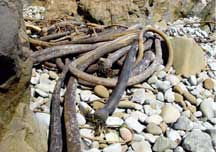 encounter what looks
like a long, snake-like sea creature with a bulbous head and green
blades of hair. This unusual specimen is not the remains of an
animal, but a seaweed called Nereocystis luetkeana. It's commonly
called the Bull whip kelp or Ribbon kelp. This seaweed is made
up of a round, hollow bulb, from which ribbon like blades emerge
from the top of the bulb. The air trapped in the bulb pulls the
kelp up so that the blades float close to the surface and receive
adequate sunlight. Blades of mature plants are shiny and leathery,
while younger plants have thinner, shinier brown blades. Attached
to the air bladder is a stipe. The stipe is a hollow tube up to
120 feet long. The lower end of the stipe is solid, which the
root like structure tenaciously clings to a rock on the bottom
sea floor.
encounter what looks
like a long, snake-like sea creature with a bulbous head and green
blades of hair. This unusual specimen is not the remains of an
animal, but a seaweed called Nereocystis luetkeana. It's commonly
called the Bull whip kelp or Ribbon kelp. This seaweed is made
up of a round, hollow bulb, from which ribbon like blades emerge
from the top of the bulb. The air trapped in the bulb pulls the
kelp up so that the blades float close to the surface and receive
adequate sunlight. Blades of mature plants are shiny and leathery,
while younger plants have thinner, shinier brown blades. Attached
to the air bladder is a stipe. The stipe is a hollow tube up to
120 feet long. The lower end of the stipe is solid, which the
root like structure tenaciously clings to a rock on the bottom
sea floor.
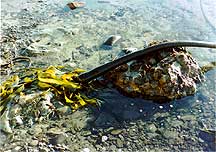 The Bull whip kelp grows in large
fields or beds far out from shore and far deeper than any tide
lays bare. The beds are located in rocky areas in the subtidal
zone and to a depth of several fathoms. Individual bull whip kelp
are occasionally
The Bull whip kelp grows in large
fields or beds far out from shore and far deeper than any tide
lays bare. The beds are located in rocky areas in the subtidal
zone and to a depth of several fathoms. Individual bull whip kelp
are occasionally 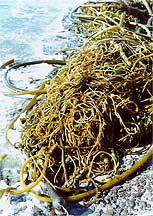 torn loose and tossed
onto the northern California shoreline by the waves or after a
storm.
torn loose and tossed
onto the northern California shoreline by the waves or after a
storm.
The Bull whip kelp was utilized by the Pacific Northwest Coast
Indians for their fishing gear and storage containers. The bulb
and parts of the stipe were used to steam bend branches of fir
for their bentwood halibut hooks. The fir sticks were shaved to
the right thickness and shape, placed in the kelp tubes, water
was added and the ends were plugged with a wad of moss. The kelp
tubes were buried in hot ashes of a dying fire and left to steam
all night. The next morning, the kelp was split open and the steamed
fir sticks were bent to shape and pressed into a wooden mold to
cool. A lightweight storage container for eulachon oil was also
made from the long kelp stems and bulb. The blades were trimmed
off and the lower end was cut off to provide an opening in which
to fill the long stems with oil. A funnel was made from another
kelp bulb to pour the oil into the stem. The open end was plugged
with a wooden stopper and tied tightly into place.
 The solid part of
the stem was used for fish lines after being soaked in fresh water,
stretched, and twisted for extra strength. Length of these were
joined together with a fisherman's knot to give the Pacific Northwest
Coast Indians a long line of great strength.
The solid part of
the stem was used for fish lines after being soaked in fresh water,
stretched, and twisted for extra strength. Length of these were
joined together with a fisherman's knot to give the Pacific Northwest
Coast Indians a long line of great strength.
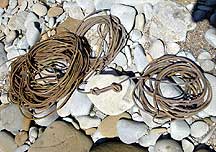
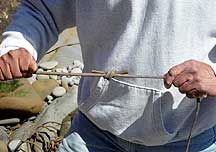
All coastal First Peoples of British Columbia made fishing
lines, nets, ropes, harpoon lines and anchor lines from Bull whip
kelp. They dried and cured the long, rope like stalks, then spliced
or plaited them together. Nancy J. Turner writes about the various
curing methods for the kelp in her book, Plant Technology of
First Peoples in British Columbia.
"Curing methods varied: some Coast Salish peoples alternately
soaked the kelp in fresh water and dried it over a smoking fire;
the Nuu-chah-nulth dried the kelp and soaked it in dogfish or
whale oil. Kelp lines were dried for storage, but had to be soaked
in water before use, or they were too brittle. After soaking
they became strong and flexible once again."
Turner also mentions other aboriginal uses of Bull whip kelp.
"Some Nuu-chah-nulth groups used fresh kelp floats as
moulds for deer suet. They poured the melted fat in through the
hollow stem, allowed it to harden, then broke the kelp away,
leaving a bulb of suet ready for storage. People sometimes made
a salve of Cottonwood buds boiled in deer fat. They poured the
mixture in a kelp bulb and let it harden: the result was a fragrant
ointment for protecting the skin from sunburn and windburn.
. . . . the Straits Salish placed the ends of Yew-wood bows inside
lengths of kelp and steamed them to mould and bend to the desired
shape. Squamish fisherman used kelp blades to keep fish fresh
and moist in the canoe. The Comox used them to line steam pits
to flavour the food and help generate steam."
The bulb and stem sections were also pickled and eaten. Young,
fresh kelp should be used for consumption. Bend the stem and if
it snaps crisply in two, the kelp is fresh. If it bends like soft
rubber, it is old. You may also substitute chopped Bull whip kelp
stems for fruit or vegetables in chutney, carrot cake, and curry
recipes.
Commercial companies use the Bull whip kelp in the preparation
of pharmaceutical supplies, dairy products, poultry feeds, and
glazing and finishing agents. It is an excellent source of potash
salts.
Contemporary musical instruments can also be made from the
Bull whip kelp. One of the instruments is a rattle.
 Find a small Bull whip kelp.
Find a small Bull whip kelp.
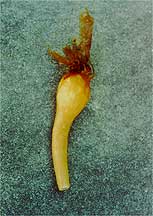 Cut off the bulbous section and part of the stem. The
dried blades make decorative attachments to the rattle.
Cut off the bulbous section and part of the stem. The
dried blades make decorative attachments to the rattle.
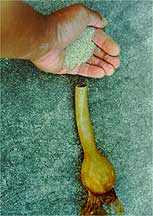 Fill the cut bulb and stem with sand to retain its
shape as the kelp dries.
Fill the cut bulb and stem with sand to retain its
shape as the kelp dries.
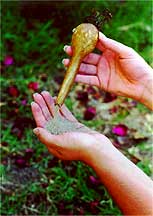 After the kelp has dried, pour out the sand and shake
out any excess sand that may be clinging onto the inside of the
bulb.
After the kelp has dried, pour out the sand and shake
out any excess sand that may be clinging onto the inside of the
bulb.
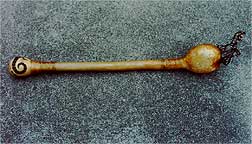
Fill the dried bulb with any rattle sounding material, like
rice, seeds, pebbles, etc. Attach a stick to the open end of your
kelp stem and lash it with cordage. You now have a kelp rattle.
The finished rattle in the photo has a small gourd with pebbles
attached to the other end of the stick.
Continued

E-mail your comments to "Dino Labiste" at KahikoArts@yahoo.com
PrimitiveWays
Home Page
We hope the information on the PrimitiveWays website is both instructional and enjoyable. Understand that no warranty or guarantee is included. We expect adults to act responsibly and children to be supervised by a responsible adult. If you use the information on this site to create your own projects or if you try techniques described on PrimitiveWays, behave in accordance with applicable laws, and think about the sustainability of natural resources. Using tools or techniques described on PrimitiveWays can be dangerous with exposure to heavy, sharp or pointed objects, fire, stone tools and hazards present in outdoor settings. Without proper care and caution, or if done incorrectly, there is a risk of property damage, personal injury or even death. So, be advised: Anyone using any information provided on the PrimitiveWays website assumes responsibility for using proper care and caution to protect property, the life, health and safety of himself or herself and all others. He or she expressly assumes all risk of harm or damage to all persons or property proximately caused by the use of this information.
© PrimitiveWays 2013
 encounter what looks
like a long, snake-like sea creature with a bulbous head and green
blades of hair. This unusual specimen is not the remains of an
animal, but a seaweed called Nereocystis luetkeana. It's commonly
called the Bull whip kelp or Ribbon kelp. This seaweed is made
up of a round, hollow bulb, from which ribbon like blades emerge
from the top of the bulb. The air trapped in the bulb pulls the
kelp up so that the blades float close to the surface and receive
adequate sunlight. Blades of mature plants are shiny and leathery,
while younger plants have thinner, shinier brown blades. Attached
to the air bladder is a stipe. The stipe is a hollow tube up to
120 feet long. The lower end of the stipe is solid, which the
root like structure tenaciously clings to a rock on the bottom
sea floor.
encounter what looks
like a long, snake-like sea creature with a bulbous head and green
blades of hair. This unusual specimen is not the remains of an
animal, but a seaweed called Nereocystis luetkeana. It's commonly
called the Bull whip kelp or Ribbon kelp. This seaweed is made
up of a round, hollow bulb, from which ribbon like blades emerge
from the top of the bulb. The air trapped in the bulb pulls the
kelp up so that the blades float close to the surface and receive
adequate sunlight. Blades of mature plants are shiny and leathery,
while younger plants have thinner, shinier brown blades. Attached
to the air bladder is a stipe. The stipe is a hollow tube up to
120 feet long. The lower end of the stipe is solid, which the
root like structure tenaciously clings to a rock on the bottom
sea floor. The Bull whip kelp grows in large
fields or beds far out from shore and far deeper than any tide
lays bare. The beds are located in rocky areas in the subtidal
zone and to a depth of several fathoms. Individual bull whip kelp
are occasionally
The Bull whip kelp grows in large
fields or beds far out from shore and far deeper than any tide
lays bare. The beds are located in rocky areas in the subtidal
zone and to a depth of several fathoms. Individual bull whip kelp
are occasionally  torn loose and tossed
onto the northern California shoreline by the waves or after a
storm.
torn loose and tossed
onto the northern California shoreline by the waves or after a
storm. The solid part of
the stem was used for fish lines after being soaked in fresh water,
stretched, and twisted for extra strength. Length of these were
joined together with a fisherman's knot to give the Pacific Northwest
Coast Indians a long line of great strength.
The solid part of
the stem was used for fish lines after being soaked in fresh water,
stretched, and twisted for extra strength. Length of these were
joined together with a fisherman's knot to give the Pacific Northwest
Coast Indians a long line of great strength.





